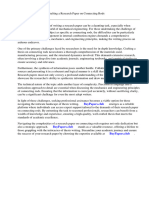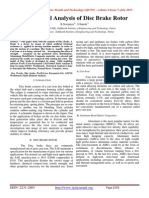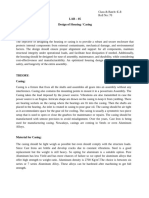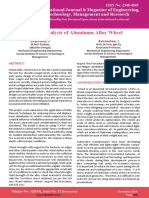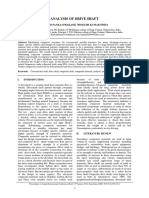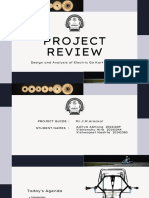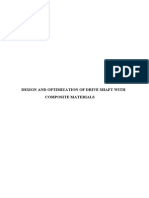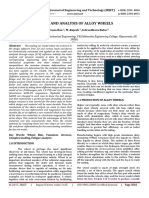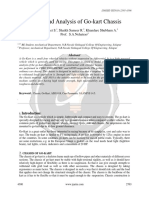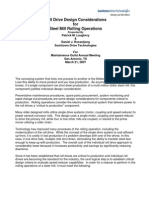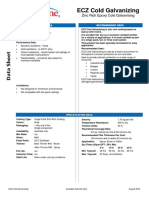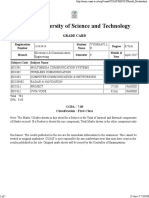Design and Analysis of Connecting Rod For Different Material Using Ansys
Design and Analysis of Connecting Rod For Different Material Using Ansys
Uploaded by
Gagan GaganCopyright:
Available Formats
Design and Analysis of Connecting Rod For Different Material Using Ansys
Design and Analysis of Connecting Rod For Different Material Using Ansys
Uploaded by
Gagan GaganOriginal Description:
Original Title
Copyright
Available Formats
Share this document
Did you find this document useful?
Is this content inappropriate?
Copyright:
Available Formats
Design and Analysis of Connecting Rod For Different Material Using Ansys
Design and Analysis of Connecting Rod For Different Material Using Ansys
Uploaded by
Gagan GaganCopyright:
Available Formats
Design and analysis of connecting rod for different material using ansys
Chapter 1
INTRODUCTION
Connecting rod interconnects the piston and the crank shaft and transmits the gas forces
from the piston to the crankshaft. Its primary function is to transmit the push and pull
from the piston pin to the crank pin and thus convert the reciprocating motion of the
piston into rotary motion of the crank. Generally connecting rods are manufactured using
carbon steel and in recent days aluminium alloys are finding its application in connecting
rod. In this work connecting rod is replaced by aluminium based composite material. And
it also describes the fabricating and testing of connecting rod. It consists of a long shank a
small end and big end. The small end of connecting rod is usually made in the form of an
eye and is provided with a bush. It is connected to the piston by means of piston pin. The
big end of connecting rod is connected to the crank by means of damping. Connecting rod
has three main zones. The piston pin end, the centre shank and the big end. The piston pin
end is the small end, the crank end is the big end and the centre shank is of I cross section.
Connecting rod is a pin jointed strut in which more weight is concentrated towards the big
end. Connecting rod is acted upon by gas loads and inertia loads during its operation. The
forces include gas forces due to combustion and inertia forces due to its own weight. The
automobile engine connecting rod is a high volume production, critical component. Every
vehicle that uses an internal combustion engine requires at least one connecting rod
depending upon the number of cylinders in the engine. Connecting rods for automotive
applications are typically manufactured by forging from either wrought steel or powdered
metal. They could also be cast. However, castings could have blow-holes which are
detrimental from durability and fatigue points of view. The fact that forgings produce
blow-hole-free and better rods gives them an advantage over cast rods. Between the
forging processes, powder forged or drop forged, each process has its own pros and cons.
Powder metal manufactured blanks have the advantage of being near net shape, reducing
material waste. However, the cost of the blank is high due to the high material cost and
sophisticated manufacturing techniques. With steel forging, the material is inexpensive
and the rough part manufacturing process is cost effective. In this work connecting rod is
replaced by aluminium based composite material and it also describes the design and
analysis of connecting rod. Generally connecting rods are manufactured using carbon
steel and in recent days aluminium alloys are used. Durability is one of the critical
importance of this component, this can be achieved by getting the knowledge about
Dept. of Mechanical Engineering, RIT, Hassan 1
Design and analysis of connecting rod for different material using ansys
different aspects such as production technology, materials, performance simulation, and
fatigue. When building a high performance engine, great attention is paid to the
connecting rods, eliminating stress risers by such techniques as grinding the edges of the
rod to a smooth radius, shot peening to induce compressive surface stresses (to prevent
crack initiation). Time and effort were necessary to create the best design for a connecting
rod to allow it to handle high stresses while minimizing weight. The reduction of weight
of connecting rods is important to ensure that the engine can operate safely in higher
RPM’s due to the decreased inertia held within the lighter rods. The goal has become to
remove as much material from these rods while still maintaining their strength and
integrity so as to safely perform under the conditions of each engine.
Fig. 1.1: Connecting rod.
1.1 Piston-Connecting Rod Assembly
A Connecting rod is a member which connecting between piston and crank shaft.
Material, such as structural steel, aluminium alloy, titanium, and cast iron are used. The
connecting rod package has to be custom tailored to the engine and the customer’s needs,
says Kerry Novak of Crower. The Small end of the connecting rod is connected to the
piston end using a gudgeon pin, wrist pin by press fit. Big end is connected to the crank
shaft using fasteners. Stresses on the connecting rod are always high due to the
combustion chamber pressure, inertia forces, which induces high value of stresses.
According to vegi[17] failure of a connecting rod, usually called "throwing a rod" is one
of the most common causes for catastrophic engine failure in cars. However, failure of the
Dept. of Mechanical Engineering, RIT, Hassan 2
Design and analysis of connecting rod for different material using ansys
connecting rod is not common since the big automobile companies try to keep very high
factor of safety of 2 or 3 above. To provide warranty, automobile companies should have
the robust design and manufacture capability. By having all this factors in consideration,
a lot of engines fail or cease due to failure of connecting rod assembly, which leaves the
companies to consider that the connecting rod as a very high risk component. For
example connecting rod failed for GM 2014 Chevy Malibu’s, 2014 Buick Regal GS ,
2014 Chevy Impala, 2014Cadillac ATS and 2015 Porsche 911 GT3, which caused
millions of dollars to be spent on recall to replace the whole engine and redesign the
connecting rod. While designing the connecting rod, Vegi[17] suggested that measures
have to be taken to reduce the stresses in the connecting rod. Methods, like grinding the
edges to give smooth surface and radius to prevent crack initiation, shot peening methods
are used which induces compressive surface stress to balance the weight of the
connecting rod and piston assembly to reduce the bending stress due to centrifugal action.
He suggest us to use high end equipment which zooms in the connecting rod to give
minute invisible cracks, which lead to brittle fracture in the ductile material.
Fig. 1.2: piston & Connecting rod assembly.
1.2 Different material used in connecting rod
1.2.1 Forged steel connecting rods
Forged steel is currently Eco boost Mustang material. AA is used mostly in aerospace
application; this material is used to handle high stress values. In figure 1 shows Forged
steel (FS) - A cosmetic trend has started by using Aluminium alloy as a CR member
Dept. of Mechanical Engineering, RIT, Hassan 3
Design and analysis of connecting rod for different material using ansys
mainly to reduce the weight, however due to engine design evolving day by day,
engineers have moved back to steel.
Fig. 1.3: Connecting Rod made of forged steel
1.2.2 Aluminium Connecting Rods
These are CNC machined out of their proprietary. Al alloys are cold extruded but a pair
of, 1000 a lot of pressure to make sure consistent grain flow and density. Aluminium
Connecting Rods are offered for many any import or domestic applications by providing
a totally custom rod at very little or no value on top of that of an "off-the-shelf" product.
To be use in high H.P. (1,200 max) and high rate (14,000 max) applications. Because of
low fatigue life, once used below high stress things drag athletics solely. Are often use
safely with daily driving. Al rods are the most effective alternative for DSM's, sturdy and
lightweight.
Aluminium 7075 (AA) - This material is used as CR to reduce the weight and it gives
cushion effect between piston head and crank shaft at higher rpm .AA CRs are generally
manufactured by using CNC machines, which has high fatigue life and stronger. AA is
used in Aircraft fittings, gears and shafts fuse parts, meter shafts and gears, missile parts,
regulating valve parts, worm gears, keys, aircraft, aerospace and defence applications,
bike frames, all-terrain vehicle (ATV) sprockets. The connecting rod transfers power to
the crank to be turned to rotational power.
Dept. of Mechanical Engineering, RIT, Hassan 4
Design and analysis of connecting rod for different material using ansys
Fig. 1.4: Connecting rod made of Aluminium
1.2.3 Steel Connecting Rods
Still connecting rods to be employed in moderate to high HP (Forged 900 max, Billet
1200 max) and moderate rate (9500-10,000 max). Appropriate for daily driving,
endurance athletics, and drag athletics. Manufacturer makes the best quality steel I beam
connecting rods for the DSM. They’re appropriate for a multiplicity of applications. A
special shot preening method will increase the fabric density on the part surface, leading
to wonderful strength and sturdiness of the ultimate product, from OEM product to high-
end race engines.
Fig. 1.5: Connecting rod made of Steel
1.2.4Titanium Connecting Rods
Metal connecting rods to be use in high power unit (1,400 max) and high revolutions per
minute (14,000) applications. Maybe use in daily driving, endurance athletics, and drag
Dept. of Mechanical Engineering, RIT, Hassan 5
Design and analysis of connecting rod for different material using ansys
athletics. Set the benchmark on racetracks round the world. Due to their low weight,
they're notably appropriate for top speed Motorsports engines.
Fig. 1.6: Connecting rod made of Titanium
1.3 Reasons for Using Aluminium
Our choice of metal for this project is Aluminium 7075 alloy. This metal is preferred due
to its light weight and low cost. The chemical composition is given in the table given
below. The choice of the metal used also depends on the type of requirement and
preference. Metals such as Aluminium are lightweight and strong and also Cost less as
compared to other materials like Titanium that is stronger but much costlier. One of the
most common usages is of Steel and its alloys.
1.4 Beam Types
An I-beam is both light weight and strong but the type of material used limits its capacity
to handle load. Whereas H-beam can handle much more stress without bending. So they
are used in high power engines. A combination of both is also used in some cases. . A
connecting rod can be of two types H-beam or I-beam or a combination of both. They are
used respectively depending on their field of application or use. An I-beam is both light
Weight and strong but the type of material used limits its capacity to handle load.
Whereas H-beam can handle much more stress without bending. So they are used in high
power engines.
1.5 Engine Wear and Rod Length
A major source of engine wear is the sideways force exerted on the piston through the
connecting rod by the crankshaft, which typically wears the cylinder into an oval cross-
section rather than circular, making it impossible for piston rings to correctly seal against
the cylinder walls. Geometrically, it can be seen that longer connecting rods will reduce
Dept. of Mechanical Engineering, RIT, Hassan 6
Design and analysis of connecting rod for different material using ansys
the amount of this sideways force and therefore lead to longer engine life. However, for a
given engine block, the sum of the length of the connecting rod plus the piston stroke is a
fixed number, determined by the fixed distance between the crank shaft axis and the top
of the cylinder block where the cylinder end fasten thus, for a given cylinder block longer
stroke, giving greater engine displacement and power, requires a shorter connecting rod
(or a piston with smaller compression height), resulting in accelerated cylinder wear.
1.6 Compound Rods
Many-cylinder multi-bank engines such as a V12 layout have little space available for
many connecting rod journals on a limited length of crankshaft. This is a difficult
compromise to solve and its consequence has often led to engines being regarded as
failures (Sunbeam Arab, Rolls-Royce Vulture).The simplest solution, almost universal in
road car engines, is to use simple rods where cylinders from both banks share a journal.
This requires the rod bearings to be narrower, increasing bearing load and the risk of
failure in a high-performance engine. This also means the opposing cylinders are not
exactly in line with each other. In certain engine types, master/slave rods are used rather
than the simple type shown in the picture above. The master rod carries one or more ring
pins to which are bolted the much smaller big ends of slave rods on other cylinders.
Certain designs of V engines use a master/slave rod for each pair of opposite cylinders. A
drawback of this is that the stroke of the subsidiary rod is slightly shorter than the master,
which increases vibration in a v engine, catastrophically so for the Sunbeam Arab. The
usual solution for high-performance aero-engines is a “forked” connecting rod. One rod is
split in two at the big end and the other is thinned to fit into this fork. The journal is still
shared between cylinders. The Rolls-Royce Merlin used this “fork and blade” style. A
common arrangement for forked rods is for the fork rod to have a single wide bearing
sleeve that spans the whole width of the rod, including the central gap. The blade rod then
runs, not directly on the crankpin, but on the outside of this sleeve. The two rods do not
rotate relative to each other, merely oscillate back and forth, so this bearing is relatively
lightly loaded and runs as a much lower surface speed. However the bearing movement
also becomes reciprocating rather than continuously rotating, which is a more difficult
problem for lubrication. A likely candidate for an extreme example of compound
articulated rod design could be the complex German 24 cylinder Junkers Jumo 222
aviation engine, meant to have unlike an X-engine layout with 24 cylinders, possessing
six cylinders per bank only four cylinders per bank and six banks of cylinders, all liquid
Dept. of Mechanical Engineering, RIT, Hassan 7
Design and analysis of connecting rod for different material using ansys
cooled with five “slave” rods pinned to one master rod, for each “layer” of cylinders in its
design.
Chapter 2
LITERATURE REVIEW
Adnan Ali Haider [2018], worked on a replacement of connecting rod with 14%weight
savings was designed by removing material from areas that showed high factor of safety
Factor of safety with respect to fatigue strength was obtained by performing FEA with
applied loads including bolt tightening load, piston pin interference load, compressive gas
load and tensile inertia load. In this research, the engine was simulated in
MSC/ADAMS/Engine software and forces acting on different parts of crank mechanism
were extracted after that connecting rod was simulated in Solid Works software, meshed
in ANSYS software and critical loads were exerted on it finally stress analysis was done .
The kinematic and kinetic analyses of the crank mechanism, stress and fatigue analysis,
and finally optimization of connecting rod were performed on Samand engine. For this
purpose, the slider-crank mechanism was simulated in MSC/ADAMS/Engine software
and forces acting on different parts of crank mechanism were extracted after that
connecting rod was simulated in ANSYS software, critical loads were exerted on it, stress
and fatigue analysis was done. For stress analysis of connecting rod it was modelled and
meshed in ANSYS (Ver. 9) software. The von miss stress and total deformation of two
different aluminium alloys were compared with the forged steel. Ramani et al focused on
the two subjects, first, load and stress analysis of the connecting rod, and second,
optimization for weight reduction. In the first part of the study, loads acting on the
connecting rod and find out stress time history at some critical point.
Magesh Kumar et.al., [2017], connecting rods are being manufactured by conventional
method of forging. Steel can be replaced by aluminium and titanium alloys on a cost of
affordability. Weight optimization is possible using composite materials without varying
the allowable stresses and boundary conditions.
Akbar H Khan [2017], research work investigated Static structural and experimental
stress analysis of two wheeler connecting rod using by theoretically, Finite element
analysis and using Photo elasticity method. Connecting rod of two wheeler 100 cc petrol
engine is taken for the analysis, Finite element analysis includes the Design and
modelling of connecting rod using Creo 2.0 and Ansys 15.0 for the Static Structural
Dept. of Mechanical Engineering, RIT, Hassan 8
Design and analysis of connecting rod for different material using ansys
analysis. Photo elasticity analysis method includes the casting of Photo elastic sheet using
Araldite AY 103 and Hardener HY 991 and then connecting rod model is prepared by
laser cutting machine. In his research paper static structural analysis is carried out to find
the von miss stresses and Stress analysis is carried out to find maximum principle stress
and reason behind the failure of connecting rod. Conclusion drawn from his study, It is
been observed that the maximum stresses are induces at the fillet section of both ends of
the connecting rod and chances of the failure of the connecting rod is found at the fillet
sections of both ends of connecting rod. Therefore, to avoid that stresses and failure
material need to be added at the fillet sections of connecting rod. By observing the
different fringes developed in the connecting rod specimen and by calculating the
maximum principle stress at that section we can say that the stresses induced in the small
end of the connecting rod are greater than the stresses induced at the big end. Form the
Photo elasticity analysis it is found that the stress concentration effect exist at both small
end and big end and it is negligible in the middle portion of the connecting rod.
Therefore, the chances of failure of the connecting rod may be at fillet section of both
ends.
Nagaraju K L [2016], in his thesis, a connecting rod is demonstrated utilizing Catia v5,
discretization utilizing Hyper Mesh and analysis utilizing Nastran. The outcome predicts
the most extreme buckling load and basic locale on the interfacing pole. It is imperative to
find the basic territory of concentrated stress for fitting adjustments. He discovered the
stresses created in interfacing pole under static loading with various stacking states of
compression and tension at crank end and pin end of connecting rod. The displacement
plot shows a very small value which does not affect the performance of the connecting
rod. The linear static analysis of the connecting rod shows that the stress generated in the
model is within the acceptable limits or maximum allowable stress. The buckling mode
analysis gives the buckling factor greater than 1 and hence it can be concluded that the
connecting rod can withstand the load applied.
Sharma Manoj, Shashikant [2015], taken connecting rod of a Mahindra Jeep CJ-340
and change its material from Al360 to PEEK. The modelling of the connecting rod is
done on Pro-E wildfire 4.0 and analysis work is done on ANSYS 11.0. The parameters
like Von misses stress, Von messes strain and displacement was obtained from ANSYS
software which shows reduction in weight and improvement in strength.
Dept. of Mechanical Engineering, RIT, Hassan 9
Design and analysis of connecting rod for different material using ansys
Kuldeep B [2013], analyzed the connecting rod by replacing Al360 material by
aluminium based composite material reinforced with silicon carbide and fly ash. He also
described the modelling and analysis of connecting rod. FEA analysis was carried out by
considering 2 materials. The parameters like von misses stress, von misses strain and
displacements were obtained from ANSYS software. Compared to the former material the
new material found to have less weight and better stiffness. It resulted in reduction of
43.48% of weight, with 75% reduction in displacement.
Marthanapalli HariPriya, K.Manohar Reddy [2013], a connecting rod for a 150cc
engine has been model in 3D modelling software cero. The actual cross section
connecting rod is I – section, which have been changed to cross section H By changing
the cross section, the weight of connecting rod is reduced by 10gms.The material used for
connecting rod is carbon steel which is replaced with Aluminium alloy A360. By
comparing the stress values for both materials, it is slightly less for Aluminium alloy
A360 than carbon steel.
Ram Bansal [2013], conducted a Dynamic simulation was on a connecting rod made of
Aluminium Alloy using finite element analysis. The connecting rod is one of the
important part of an engine. Connecting rod of the single cylinder four stroke diesel
engine is used. After measurements were taken, connecting rods were modelled using
CATIA software and saved in 'IGES' format. Then, the model of connecting rod (IGES
format) imported into ANSYS software. In his analysis of connecting rod was performed
under Dynamic load for Stress analysis, and optimization. The pressure-volume diagram
was used to calculate the load boundary condition in dynamic simulation model, and
other simulation inputs were taken from the engine Specification chart. The data obtained
at engine run were plotted on graph by Engine-soft Software. The maximum deformation,
maximum stress point and dangerous areas are found by the stress analysis of connecting
rod. This analysis uses a different mesh to get more precise results. The relationship
between the stress and the nodal displacement is explained by the modal analysis of
connecting rod. The results would provide a valuable theoretical foundation for the
optimization and improvement of connecting rod. Dynamic load analysis was performed
to determine the in service loading of the connecting rod and FEA was conducted to find
stresses at critical locations. The maximum deformation appears at the centre of big end
& small end bearings inner fibre surface. The areas subjected to crushing due to crank
shaft & gudgeon pin is shown through analysis after implementing boundary conditions.
Dept. of Mechanical Engineering, RIT, Hassan 10
Design and analysis of connecting rod for different material using ansys
The connecting rod deformation was mainly bending due to buckling under the critical
loading. And the maximum deformation was located due to crush & shear failure of the
big & small end bearings. So these areas prone to appear the fatigue crack. Base on the
results, we can forecast the possibility of mutual interference between the connecting rod
and other parts. The results provide a theoretical basis to optimize the design and fatigue
life calculation.
VenuGopalVegi and Leela Krishna Vegi [2013], in their paper describe designing and
analysis of a connecting rod. Currently existing connecting rods are made of carbon steel.
The model of connecting rod is modelled using CATIA software and analysis is carried
out on ANSYS software. Finite element analysis is carried out on a connecting rod made
of forged steel. The parameters like Von mises stress, strain, deformation, factor of safety
etc were calculated and found that forged steel have more factor of safety, reduced
weight, greater stiffness than carbon steel.
Vikas Gupta [2013], in his research work altered the dimensions of already existing
design of a connecting rod of a tractor engine. This analysis was done under static and
fatigue loading. Optimization was done under same boundary and loading conditions for
validation in few stress and fatigue parameters. The critical regions under both static and
fatigue analysis are identified and improved. The connecting rod was modelled and
optimized for the reduced weight, improved life and manufacturability. The material was
kept same and a significant change was observed in Von mises stress. 9.4% less stress
was observed at critical point under static load conditions. Only 5 gm of weight was
reduced which is very low. From this we can conclude that not only materials but also
design parameters can be considered for optimization. The comparison of fatigue
behaviour of forged steel and powder metal connecting rods was discussed by A. Afzal et
al. The experiments included strain controlled specimen testing with specimen obtained
from the connecting rods as well as strain controlled connecting rod bench testing.
Monotonic and cyclic deformation behaviour and strain controlled fatigue properties of
two materials are evaluated and compared. The stress concentration factors were obtained
from FEA, and modified Goodman equation was used to account for the mean stress
effect. The connecting rod is a most stressed part in internal combustion engine. During
its operation various stresses are acting on it. The effect of compressive stress is more due
to gas pressure and whipping stress. Fanil Desai and all compared two samples of
connecting rod made of forged steel. Static analysis was done using ANSYS software and
Dept. of Mechanical Engineering, RIT, Hassan 11
Design and analysis of connecting rod for different material using ansys
experimental analysis with Universal Testing Machine (UTM). Experimental results were
verified with the numerical results. To reduce weight and cost of forged steel connecting
rod, Ambrish Tiwari et al, extremely used the numerical tools during the development
phase. Therefore, to complete understand the mechanisms involved as well as the
reliability of the numerical methodology are extremely important to take technological
advantages, such as, to reduce project lead time and prototypes cost reduction. The work
shows complete FEA methodology to explore weight and cost reduction opportunities for
production of forged steel connecting rod. Considering the modified Goodman diagram,
fatigue study based on stress life theory was also performed.
Ramanpreet Singh [2013], in his study used isotropic and orthotropic composite
materials. The modelling of connecting rod was done using CATIA v5 and stress
analysed in MSC. PATRAN. Linear static analysis was carried out for both materials with
tetrahedron with element size of 4mm to obtain stress results. Comparison of both
materials was done keeping the boundary conditions same. Author concluded that there
was a reduction of 33.99% of stresses when isotropic material (i.e. steel) is replaced with
orthotropic material (i.e. E-glass/Epoxy). Also there was reduction in displacement of
about 0.026%.
K. Sudershan Kumar [2012], describes modelling and analysis of connecting rod.
Existing connecting rod is manufactured by using Carbon steel. In his project connecting
rod is replaced by Aluminium reinforced with Boron carbide for Suzuki GS150R
motorbike. A 2D drawing is drafted from the calculations. A parametric model of
connecting rod is model using PRO-E 4.0 software. Analysis is carried out by using
ANSYS software. Finite element analysis of connecting rod is done by considering two
materials, viz. Aluminium Reinforced with Boron Carbide and Aluminium 360. The best
combination of parameters like Von misses stress and strain, Deformation, Factor of
safety and weight reduction for two wheeler connecting rod were done in ANSYS
software. Compared to carbon steel, aluminium boron carbide and aluminium 360,
Aluminium boron carbide is found the working factor of safety is nearer to theoretical
factor of safety in aluminium boron carbide. Percentage of reduction in weight is same in
Aluminium 360 and aluminium boron carbide. Percentage of increase in stiffness in
aluminium boron carbide is more. Percentage of reduction in stress aluminium boron
carbide and aluminium 360 is same.
Dept. of Mechanical Engineering, RIT, Hassan 12
Design and analysis of connecting rod for different material using ansys
Chapter 3
PROBLEM STATEMENT
The present work provides an insight of bending stress acting along the body of
connecting rod due to inertia forces acting on the connecting rod which are known by
name of whipping stress. The bending moment is dependent on material selected for
connecting rod and is used to evaluate the bending stress acting on steel, Al7075, and
high strength carbon fibre. The comparative study of bending stress parameter provides
the best material to be selected for connecting rod of engines.
Dept. of Mechanical Engineering, RIT, Hassan 13
Design and analysis of connecting rod for different material using ansys
Chapter 4
OBJECTIVES
The below objectives are framed based on the literature survey,
To study the design parameters of connecting.
To analyse the behaviour of connecting rod.
To check the feasibility of different material as connecting rod.
Improving the stability of connecting rod by material change.
Dept. of Mechanical Engineering, RIT, Hassan 14
Design and analysis of connecting rod for different material using ansys
Chapter 5
METHODOLOGY
The following methodology describes the flow of work to achieve the above mentioned
objectives,
Literature survey.
Selection of materials.
Designing of connecting rod.
Modelling and analysis of connecting rod using different material [ANSYS v18].
Comparison and tabulation of obtained results.
Dept. of Mechanical Engineering, RIT, Hassan 15
Design and analysis of connecting rod for different material using ansys
Chapter 6
WORK TO BE DONE
Presently the literature part and framing the objectives and methodology based on
literature review is done, further need to,
Study the processing of connecting rod.
Loads on connecting rod.
Designing connecting rod.
Modelling and analysis.
Comparison of results.
Dept. of Mechanical Engineering, RIT, Hassan 16
Design and analysis of connecting rod for different material using ansys
REFERENCES
[1]. Haider, Adnan Ali, Akash Kumar, Ajinkya Chowdhury, Moin Khan, and P.
Suresh. "Design and Structural Analysis of Connecting Rod." (2018).
[2]. Sarate, Pawan, G. R. Kesheorey, and Manish Shah. "A Comparative Study on
Forecasting and Analysis of 4140 Material Composition of Connecting Rod for
Various Applications." (2017).
[3]. Kumar, Magesh, and Ankush K. Biradar. "A Review Paper on Design Analysis of
Connecting Rod." International Journal on Recent and Innovation Trends in
Computing and Communication 5, no. 6 (2017).
[4]. Dontul, Ganesh N., and Kaustubh S. Mangrulkar. "Determination of Fatigue Life
of a Connecting Rod of a Motor-Bike Using FEA." (2017).
[5]. Ramasubramanian, S., M. Chandrasekaran, R. Sridhar, and K. Karunakaran.
“Design, Manufacture and Analysis of Al/SiC MMCs for Connecting Rod." In
IOP Conference Series: Materials Science and Engineering, vol. 183, no. 1, p.
012009. IOP Publishing, (2017).
[6]. Khan, Akbar H., and Dhananjay R. Dolas. "Design, Modeling and Static
Structural Analysis of Connecting rod." Imperial Journal of Interdisciplinary
Research 3, no. 1 (2016).
[7]. Chaudhary, Aditya, and Dr Prashanta Kr Mahato. "Fabrication, Material and
Design Modification based Analysis of Connecting Rod Using
FEA." International Journal of Research in Advent Technology 4, no. 11 (2016).
[8]. Naik, Shashidar K., et al. "Connecting Rod Made Using Particulate Reinforced
Aluminium Metal Matrix Composite-A Review." International Journal of
Emerging Technologies and Innovative Research JETIR. Vol. 2. No. 12 (January-
2016).
[9]. Jayant, Jitendra, and Julee Sahu. "Design and Development of Connecting Rod
with Aluminium Alloy Replacing Iron Based Alloy Material for Reciprocating
Piston Engine." International Journal of Technology Research and Management,
ISSN (Online) (2015).
Dept. of Mechanical Engineering, RIT, Hassan 17
Design and analysis of connecting rod for different material using ansys
[10]. Samal, Prasanta Kumar, B. Murali, and Tajmul Pasha. "Finite Element Analysis
of Connecting Rod of IC Engine." MATEC Web of Conferences. Vol. 34. EDP
Sciences (2015).
[11]. Joshi, Prateek, and Mohammad UmairZaki. "FEM analysis of connecting rod of
different materials using ANSYS." International Journal of Engineering and
Techniques 3, no. 1 (2015).
[12]. Singh, Ramanpreet. "Stress analysis of orthotropic and isotropic connecting rod
using finite element method." International journal of mechanical engineering and
robotics research 2, no. 2 (2013).
[13]. Kuldeep, B., and L. R. Arun. "Mohammed Faheem , Analysis And Optimization
Of Connecting Rod Using Alfasic Composites." International Journal of
Innovative Research in Science, Engineering and Technology (2013).
[14]. Hari Priya, Marthanapalli, and K. Manohar Reddy. "Materialized Optimization of
Connecting Rod for Four Stroke Single Cylinder Engine." International Journal of
Computational Engineering Research 3, no. 10 (2013).
[15]. Bansal, Ram. "Dynamic simulation of a connecting rod made of aluminium alloy
using finite element analysis approach." IOSR Journal of Mechanical and Civil
Engineering 5, no. 2 (2013).
[16]. Prakash, Om, Vikas Gupta, and Vinod Mittal. "Optimizing the design of
connecting rod under static and fatigue loading." International Journal Of
Research İn Management, Science & Technology 1 (2013).
[17]. Vegi, Leela Krishna, and Venu Gopal Vegi. "Design and analysis of connecting
rod using forged steel." International Journal of Scientific & Engineering
Research 4, no. 6 (2013).
Dept. of Mechanical Engineering, RIT, Hassan 18
You might also like
- Weld Like a Pro: Beginning to Advanced TechniquesFrom EverandWeld Like a Pro: Beginning to Advanced TechniquesRating: 4.5 out of 5 stars4.5/5 (6)
- Dimensions, Weights and Properties of Special and Standard Structural Steel Shapes Manufactured by Bethlehem Steel CompanyFrom EverandDimensions, Weights and Properties of Special and Standard Structural Steel Shapes Manufactured by Bethlehem Steel CompanyNo ratings yet
- Spec - Fuel Gas Conditioning SystemDocument416 pagesSpec - Fuel Gas Conditioning SystemVijaya Kumar S100% (4)
- Front DifferentialDocument2 pagesFront DifferentialMark MuscatNo ratings yet
- Form A: Jabatan Bomba Dan Penyelamat, MalaysiaDocument3 pagesForm A: Jabatan Bomba Dan Penyelamat, MalaysiaKazehaya AliNo ratings yet
- English - Unit 1Document22 pagesEnglish - Unit 1Putra AirlanggaNo ratings yet
- Design and Analysis of Connecting Rod For Different Material Using AnsysDocument7 pagesDesign and Analysis of Connecting Rod For Different Material Using AnsysGagan GaganNo ratings yet
- A Report Entitled: Analysis of Connecting Rod Using Different MaterialsDocument27 pagesA Report Entitled: Analysis of Connecting Rod Using Different MaterialsPathan ShahidkhanNo ratings yet
- International Journal of Computational Engineering Research (IJCER)Document5 pagesInternational Journal of Computational Engineering Research (IJCER)International Journal of computational Engineering research (IJCER)No ratings yet
- Research Paper On Connecting RodDocument5 pagesResearch Paper On Connecting Rodskpcijbkf100% (1)
- Design and Optimization of Automotive Cardan Shafts For Industrial Applications With Enhanced Performance and DurabilityDocument10 pagesDesign and Optimization of Automotive Cardan Shafts For Industrial Applications With Enhanced Performance and DurabilityUNITED CADDNo ratings yet
- RODDocument3 pagesRODakampuriraamon14No ratings yet
- Design and Analysis of Connecting Rod Using Different MaterilasDocument9 pagesDesign and Analysis of Connecting Rod Using Different MaterilasVIVEK UPADHYAYNo ratings yet
- Structural Analysis of Disc Brake RotorDocument4 pagesStructural Analysis of Disc Brake RotorseventhsensegroupNo ratings yet
- BielaDocument2 pagesBielaAlin RachieruNo ratings yet
- Piston WordDocument17 pagesPiston Wordhi_mayank1No ratings yet
- Dai Gil Lee (2004) Design and Manufacture of An Automotive Hybrid Aluminum-Composite Drive ShaftDocument13 pagesDai Gil Lee (2004) Design and Manufacture of An Automotive Hybrid Aluminum-Composite Drive Shaftmc_ensNo ratings yet
- Ijett V38P253 PDFDocument7 pagesIjett V38P253 PDFKaustubh DwivediNo ratings yet
- Msd Lab 5 CasingDocument6 pagesMsd Lab 5 Casingpruthviraj.shinde23No ratings yet
- Design & Optimization Gudgeon Pin For C.I. EngineDocument12 pagesDesign & Optimization Gudgeon Pin For C.I. EngineIJRASETPublicationsNo ratings yet
- Design and Development of Laminated Aluminum Glass Fiber Drive Shaft For Light Duty VehiclesDocument9 pagesDesign and Development of Laminated Aluminum Glass Fiber Drive Shaft For Light Duty VehiclesMatthew SmithNo ratings yet
- Modeling and Analysis of Connecting Rod of Two Wheeler (Hero Honda Splendor)Document4 pagesModeling and Analysis of Connecting Rod of Two Wheeler (Hero Honda Splendor)rajeshNo ratings yet
- Ijett V38P253Document7 pagesIjett V38P253Burak KoyuncuogluNo ratings yet
- Milestone No. 01 - CAE LABDocument9 pagesMilestone No. 01 - CAE LABMuhammad Junaid Rajput FatimaNo ratings yet
- Design and Analysis of Alloy Wheel Rim by Using Different MaterialDocument12 pagesDesign and Analysis of Alloy Wheel Rim by Using Different MaterialIJRASETPublicationsNo ratings yet
- Analysis and Evaluation of Connecting Rod Using Composite Materials (Al SiC)Document12 pagesAnalysis and Evaluation of Connecting Rod Using Composite Materials (Al SiC)Selvakumar SubbaiahNo ratings yet
- BIW Thinwall Structures PDFDocument3 pagesBIW Thinwall Structures PDFsmani170No ratings yet
- Analysis of Stresses Induced in Connecting Rod of Two Wheeler EngineDocument9 pagesAnalysis of Stresses Induced in Connecting Rod of Two Wheeler EngineShashank RajoriaNo ratings yet
- Al7075 AnsysDocument7 pagesAl7075 AnsysBlack MNo ratings yet
- Design and Static Structural Analysis of Crank Shaft: ISSN 2319-8885 Vol.04, Issue.07, March-2015, Pages:1393-1398Document6 pagesDesign and Static Structural Analysis of Crank Shaft: ISSN 2319-8885 Vol.04, Issue.07, March-2015, Pages:1393-1398Yuliantari YuliantariNo ratings yet
- Disc Brake Rotor ProjectDocument9 pagesDisc Brake Rotor ProjectShobha raniNo ratings yet
- Automotive Wheel Design Criteria For Low Cycle FatigueDocument93 pagesAutomotive Wheel Design Criteria For Low Cycle Fatigueapi-237759198No ratings yet
- Case Study: CrankshaftsDocument12 pagesCase Study: CrankshaftsDHRUV SINGHALNo ratings yet
- Manufacturing Processes LabDocument6 pagesManufacturing Processes Labkhizeraftab1018No ratings yet
- Connecting Rod TechDocument9 pagesConnecting Rod TechadolfoclesNo ratings yet
- Fatigue Analysis of Alloy Wheel For Passenger Car Under Radial LoadDocument10 pagesFatigue Analysis of Alloy Wheel For Passenger Car Under Radial Loadsuraj dhulannavarNo ratings yet
- Leaf Spring PDFDocument14 pagesLeaf Spring PDFSharanu Reshmi0% (1)
- Semi Solid Steering KnuckleDocument8 pagesSemi Solid Steering KnuckleKrishna Mohan T.RNo ratings yet
- Impact Analysis of Aluminum Alloy Wheel - (V. Sivakrishna, J. Balabashker) PDFDocument11 pagesImpact Analysis of Aluminum Alloy Wheel - (V. Sivakrishna, J. Balabashker) PDFpezz07No ratings yet
- PowderMet2015-San Diego FinalDocument12 pagesPowderMet2015-San Diego FinalMilan JoshiNo ratings yet
- Ijesrt: International Journal of Engineering Sciences & Research TechnologyDocument13 pagesIjesrt: International Journal of Engineering Sciences & Research Technologymesfin DemiseNo ratings yet
- ShaftDocument6 pagesShaftAdiNo ratings yet
- Analysis of Drive Shaft: Bhirud Pankaj Prakash, Bimlesh Kumar SinhaDocument6 pagesAnalysis of Drive Shaft: Bhirud Pankaj Prakash, Bimlesh Kumar SinhakumarNo ratings yet
- Minimization of Defect in Aluminium Alloy Wheel Casting Using 7 QC ToolsDocument4 pagesMinimization of Defect in Aluminium Alloy Wheel Casting Using 7 QC ToolsijaertNo ratings yet
- Best 30 D&A ABSTRACTDocument30 pagesBest 30 D&A ABSTRACTRajadurai BaskaranNo ratings yet
- Connecting Rod Analysis ThesisDocument6 pagesConnecting Rod Analysis ThesisCanYouWriteMyPaperForMeUK100% (1)
- Project Review 2Document19 pagesProject Review 2Vishwajeet NashteNo ratings yet
- Shaft AnalysisDocument28 pagesShaft Analysissaravan2015No ratings yet
- Fem Simulation of Connecting Rod For Minimal Distortion Using Aluminum AlloyDocument11 pagesFem Simulation of Connecting Rod For Minimal Distortion Using Aluminum AlloyInternational Journal of Innovative Science and Research TechnologyNo ratings yet
- Indian Institute of Technology Roorkee Mechanical & Industrial DepartmentDocument13 pagesIndian Institute of Technology Roorkee Mechanical & Industrial DepartmentGurpreet SinghNo ratings yet
- Latest Technology/Processes For Welded and Riveted Joints New Technology For Welding AluminumDocument3 pagesLatest Technology/Processes For Welded and Riveted Joints New Technology For Welding AluminumPandaNo ratings yet
- Piston: Parts, Types, Working, Piston Clearance, Shape and MoreDocument12 pagesPiston: Parts, Types, Working, Piston Clearance, Shape and MoreAndre RichardNo ratings yet
- Fatigue Analysis PDFDocument6 pagesFatigue Analysis PDFPallavit NigamNo ratings yet
- Irjet V4i6386Document7 pagesIrjet V4i6386MINDWORKZ MECHNo ratings yet
- Design and Analysis of Go Kart Chassis Ijariie4300 PDFDocument7 pagesDesign and Analysis of Go Kart Chassis Ijariie4300 PDFDeepak RameshNo ratings yet
- Report On Engine BlocksDocument7 pagesReport On Engine Blocksmanshulakesh59No ratings yet
- Study On Design of Casing of Steam TurbineDocument3 pagesStudy On Design of Casing of Steam Turbinesevero97No ratings yet
- Factor Servicio Re Duct OresDocument13 pagesFactor Servicio Re Duct OresVillegas Lopez GermanNo ratings yet
- Selection of Copper vs. Aluminum Rotors For Induction MotorsDocument11 pagesSelection of Copper vs. Aluminum Rotors For Induction MotorskachanansNo ratings yet
- Fatigue and Static Structural Analysis of Car Wheel Using Finite Element Method - A Review-34038Document6 pagesFatigue and Static Structural Analysis of Car Wheel Using Finite Element Method - A Review-34038kiran_sridharaNo ratings yet
- The Ford SOHC Pinto & Sierra Cosworth DOHC Engines high-peformance manual: For Road & TrackFrom EverandThe Ford SOHC Pinto & Sierra Cosworth DOHC Engines high-peformance manual: For Road & TrackNo ratings yet
- The Modern Chassis: A Practical Manual of Automotive Chassis and Suspension DesignFrom EverandThe Modern Chassis: A Practical Manual of Automotive Chassis and Suspension DesignRating: 3.5 out of 5 stars3.5/5 (3)
- Bearings And Bearing Metals: A Treatise Dealing with Various Types of Plain Bearings, the Compositions and Properties of Bearing Metals, Methods of Insuring Proper Lubrication, and Important Factors Governing the Design of Plain BearingsFrom EverandBearings And Bearing Metals: A Treatise Dealing with Various Types of Plain Bearings, the Compositions and Properties of Bearing Metals, Methods of Insuring Proper Lubrication, and Important Factors Governing the Design of Plain BearingsRating: 4 out of 5 stars4/5 (1)
- Epson T21 24 27 S21Document107 pagesEpson T21 24 27 S21Ion IonutNo ratings yet
- ECZ Cold Galvanizing PDSDocument2 pagesECZ Cold Galvanizing PDSikrimasabriNo ratings yet
- 12 G Diagrama Electrico PDFDocument7 pages12 G Diagrama Electrico PDFcristian chuquicondor torres100% (2)
- Bladder Accumulators HYDACDocument19 pagesBladder Accumulators HYDACPopescu Ioana Corina100% (1)
- Date Sheet For PGDM, Pgditm & Other Programmes For December, 2011 Term-End Exams (Tentative)Document8 pagesDate Sheet For PGDM, Pgditm & Other Programmes For December, 2011 Term-End Exams (Tentative)Debojit HoreNo ratings yet
- Nylon maNUfacturersDocument12 pagesNylon maNUfacturersMihir GandhiNo ratings yet
- Pneumatic Conveyign - Fly Ash ReferencesDocument9 pagesPneumatic Conveyign - Fly Ash ReferencesLucien DraayNo ratings yet
- F-Class: Four Bearing Vibrating ScreenDocument23 pagesF-Class: Four Bearing Vibrating ScreenkosmcNo ratings yet
- NCERT Book For Class 1 Maths Chapter 12Document6 pagesNCERT Book For Class 1 Maths Chapter 12swatichoudharyNo ratings yet
- 00-Event Level - Prefunction - Demo Structural Demolition NotesDocument1 page00-Event Level - Prefunction - Demo Structural Demolition NoteshuyxpkissNo ratings yet
- Amkus BrochureDocument20 pagesAmkus BrochureForum PompieriiNo ratings yet
- MVC Plus User ManualDocument79 pagesMVC Plus User ManualhtuhnitNo ratings yet
- Introducing Ziba - Wireless PAR Freedom in A Compact, Battery-Powered, Multi-Purpose LED Event Light From Luxium Lighting With DMX and Mobile App ControlDocument3 pagesIntroducing Ziba - Wireless PAR Freedom in A Compact, Battery-Powered, Multi-Purpose LED Event Light From Luxium Lighting With DMX and Mobile App ControlPR.comNo ratings yet
- BVOT Iron Roughneck ManualDocument124 pagesBVOT Iron Roughneck ManualHernan Patarroyo0% (2)
- Reinforcing Steel and AccessoriesDocument4 pagesReinforcing Steel and AccessoriesTheodore TheodoropoulosNo ratings yet
- Bearing DesignationsDocument5 pagesBearing DesignationsIván CentenoNo ratings yet
- Demonstration OF Braking SYSTEM of An EngineDocument13 pagesDemonstration OF Braking SYSTEM of An EngineKryptonNo ratings yet
- Bohler Ti 52Document1 pageBohler Ti 52Anonymous nKOyHbNo ratings yet
- Mathcad - GBP On Parking 2Document3 pagesMathcad - GBP On Parking 2Jose AngelesNo ratings yet
- Escalator Planning GuideDocument24 pagesEscalator Planning GuideFERNSNo ratings yet
- Cochin University of Science and Technology: Grade CardDocument1 pageCochin University of Science and Technology: Grade CardVyshnavi L RNo ratings yet
- CP 1 2000 Nema Shunt CapDocument42 pagesCP 1 2000 Nema Shunt CapDaniel E MontenegroNo ratings yet
- List of Oil & Gas CompaniesDocument3 pagesList of Oil & Gas CompaniesRagerishcire KanaalaqNo ratings yet
- Iqwq FT LSPDS 00 030604 - 1Document15 pagesIqwq FT LSPDS 00 030604 - 1hapinefeNo ratings yet
- B. Gerard, - Fundamentals of Hardfacing by Fusion Welding, Welding Alloys Group, USADocument35 pagesB. Gerard, - Fundamentals of Hardfacing by Fusion Welding, Welding Alloys Group, USAScienticsPeerNo ratings yet
- Rate Build UpDocument35 pagesRate Build UpAliNo ratings yet









